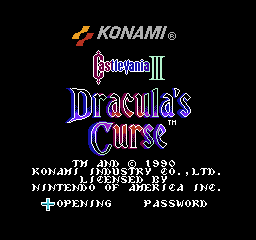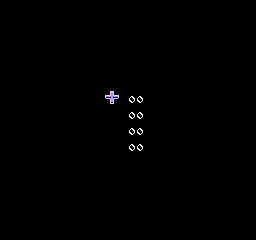Castlevania III: Dracula's Curse
| Castlevania III: Dracula's Curse |
|---|
|
Also known as: Akumajou Densetsu (JP)
|
Castlevania III: Dracula's Curse completes the 8-bit Castlevania trilogy. Set centuries before the first game, the protagonist of Dracula's Curse is an ancestor of Simon Belmont. Despite dropping the non-linear elements of Simon's Quest, the game contains branching pathways and the ability to switch playable characters.
Contents
Sub-Pages
| Notes |
| Regional Differences A surprising amount for a NES game. |
Sound Test
At the title screen hold A or B (or both), then press Start. The sound test was designed to fit at the bottom of the Japanese version's title screen; the routine wasn't altered to take the larger title screen of the US version into account, and displays it over the copyright text as a result. The European version does a better job of not displaying anything over anything else.
| Japan | US | Europe |
|---|---|---|
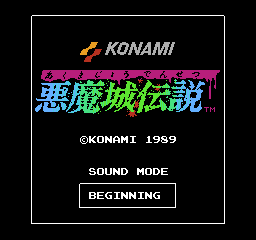
|
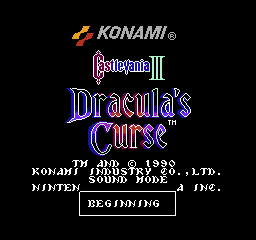
|
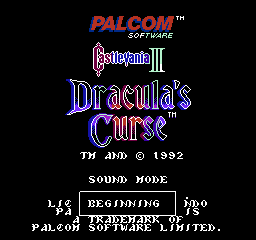
|
Debug Menu
Game Genie code KVEVPYEP sets memory address $0018 (a global event/menu index) to $07 when beginning a game, which is one byte higher than normal and hence allows access to the debug menu. Note that the menu is very similar to the one in the Teenage Mutant Ninja Turtles prototype, right down to the cross-shaped cursor.
When starting a level from this menu, the first 100 points you score will instantly give you a 1up.
Controls:
- A - Increase value.
- B - Decrease value.
- Select - Move cursor.
- Start - Begin game.
Options 1, 2, 3
This allows you to choose which stage, act and screen you want to start out on. For a full list of every room, see the Notes page.
- 00: Stage 1-01
- 01: Stage 2-01
- 02: Stage 3-00
- 03: Stage 4-0A (after the second flight of stairs)
- 04: Stage 5-0A
- 05: Stage 6-0A
- 06: Stage 4-01 (starts you off in a wall, unable to move)
- 07: Stage 5-01 (after the first flight of stairs)
- 08: Stage 6-01 (after the first flight of stairs)
- 09: Stage 6-01 (the cave area)
- 0A: Stage 7-01
- 0B: Stage 7-0A
- 0C: Stage 8-01
- 0D: Stage 9-01
- 0E: Stage A-01 (after the autoscrolling part)
Option 4
This allows you to choose which partner you start out with:
- 00: Nobody
- 01: Sypha
- 02: Grant
- 03: Alucard
Unused Graphics
There are graphics for melted sub-weapons that went unused.
Build Dates
At the end of the PRG ROM is a text string identifying the date on which that version of the game was compiled. A similar ID is found in many other Konami games.
| Japan | US | Europe |
|---|---|---|
| SAMP891007 | MAST900000 | MAST920117 |
"MAST" means it's the "master" version of the game, and the numbers represent the date. The Japanese version was originally a Sample ("SAMP") version built on October 7, 1989; the US version was built at some point in 1990; and the European version was built on January 17, 1992.
- Pages missing developer references
- Games developed by Konami
- Pages missing publisher references
- Games published by Konami
- Games published by Palcom Software
- NES games
- Pages missing date references
- Games released in 1989
- Games released in December
- Games released on December 22
- Games with debugging functions
- Games with hidden sound tests
- Games with hidden level selects
- Games with regional differences
- Pages with a Data Crystal link
- Castlevania series
Cleanup > Pages missing date references
Cleanup > Pages missing developer references
Cleanup > Pages missing publisher references
Games > Games by content > Games with debugging functions
Games > Games by content > Games with hidden level selects
Games > Games by content > Games with hidden sound tests
Games > Games by content > Games with regional differences
Games > Games by content > Pages with a Data Crystal link
Games > Games by developer > Games developed by Konami
Games > Games by platform
Games > Games by publisher > Games published by Konami
Games > Games by publisher > Games published by Konami > Games published by Palcom Software
Games > Games by release date > Games released in 1989
Games > Games by release date > Games released in December
Games > Games by release date > Games released in December > Games released on December 22
Games > Games by series > Castlevania series
The Cutting Room Floor > Unimportant Awards > NES games
